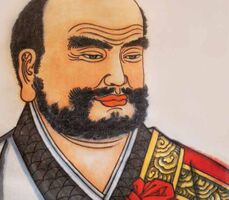Kumārajīva
| PersonType | Category:Translators |
|---|---|
| MainNamePhon | Kumārajīva |
| MainNameDev | कुमारजीव |
| MainNameChi | 鳩摩羅什 |
| MainNamePin | Jiumoluoshi |
| YearBirth | 344 |
| YearDeath | 409/413 |
| BornIn | Kucha, Central Asia |
| IsInGyatsa | No |
| BnwShortPersonBio | The most influential translator of Buddhist texts into Chinese. He is regarded by tradition as the founder of the Chinese San lun zong or “Three Treatises” branch of the Madhyamaka school of Mahāyāna philosophy. According to his hagiography, Kumārajīva was born in the Central Asian petty kingdom of Kucha, where he was related to the royal family on his mother's side. In his youth, he studied Sarvāstivāda doctrine in Kashmir but was later converted to Mahāyāna at the Central Asian oasis town of Kashgar by the monk Buddhayaśas. When the Chinese general Lü Guang conquered Kucha in 383, he took Kumārajīva back with him to Liangzong near the Chinese outpost of Dunhuang as a prize, only to lose the eminent scholar-monk to Yaoxing (r. 394–416) when the Latter Qin ruler reconquered the region in 401. During his eighteen years as a hostage, Kumārajīva apparently learned to speak and read Chinese and seems to have been one of the first foreign monks able to use the language fluently. A year later in 402, Yaoxing invited Kumārajīva to the capital of Chang'an, where he established a translation bureau under Kumārajīva's direction that produced some of the most enduring translations of Buddhist texts made in Chinese. The sheer number and variety of the translations made by Kumārajīva and his team were virtually unmatched until Xuanzang (600/602–664 CE). Translations of some seventy-four texts, in 384 rolls, are typically attributed to Kumārajīva, including various sūtras, such as the Pañcaviṃśatisāhasrikāprajñāpāramitāsūtra, Aṣṭasāhasrikāprajñapāramitā, Saddharmapuṇḍarīkasūtra, Vimalakīrtinirdeśa, Sukhāvatīvyūhasūtra, and Vajracchedikāprajñāpāramitāsūtra, and important śāstras such as the Mūlamadhyamakakārikā, Śataśāstra, Dvādaśamukhaśāstra, and the Dazhidu lun. Because Kumārajīva was one of the first foreign monks to have learned Chinese well, he produced translations that were readily comprehensible as Chinese, and his translations remain the most widely read in East Asia of any translator’s; indeed, where there are multiple translations of a scripture, it is almost inevitably Kumārajīva’s that remains part of the living tradition. The accuracy of his translations is said to be attested by the fact that his tongue remained unburned during his cremation. Along with his correspondences with the monk Lushan Huiyuan found in the Dasheng dayi zhang, these translations laid the foundation for Mahāyāna thought, and especially Madhyamaka philosophy, in China. His many famous disciples include Daosheng, Sengzhao, Daorong, and Sengrui, who are known collectively as the "four sages." (Source: "Kumārajīva." In The Princeton Dictionary of Buddhism, 452–53. Princeton University Press, 2014. http://www.jstor.org/stable/j.ctt46n41q.27) |
| Other wikis |
If the page does not yet exist on the remote wiki, you can paste the tag |

